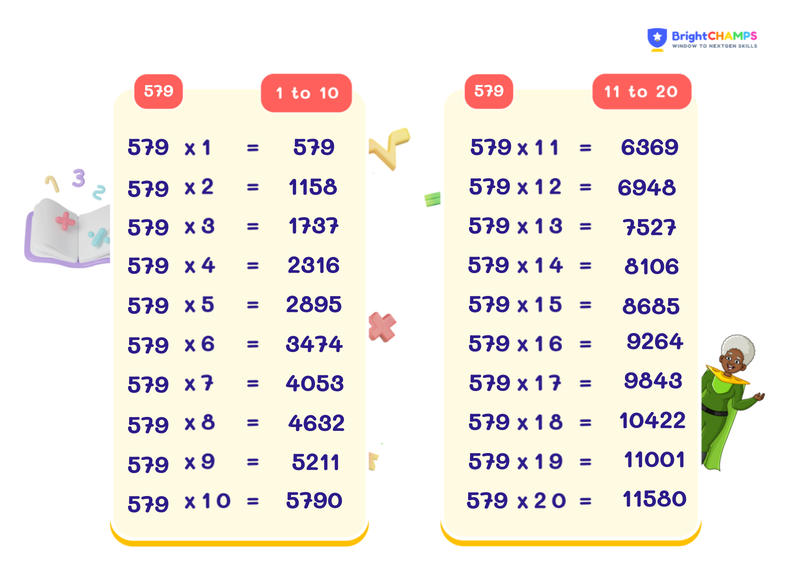
 215 Learners
215 LearnersLast updated on May 26th, 2025

Table of 579

A times table is a chart that shows the results of multiplying a number with the whole number. Learning the times table will help kids understand multiplication. We use an algebraic system to define multiplication operations, construction, estimation, schoolwork, exams, etc. In this topic, we will learn about the table of 579.
What is the Multiplication Table of 579?
Multiplication was used by people over 4000 years ago. Babylonians were considered the first to use it in clay tablets. Multiplication tables are created as a result of people's search for easier ways to solve problems. Learning multiplication tables has numerous advantages. Kids can answer quickly if they know their times table. It also helps to enhance their understanding skills. Being more familiar with the tables improves children's memory and confidence.
Multiplying the whole number (1, 2, 3, 4, 5, and so on) by 579 gives the product of the multiplication table of 579. Here are some examples:
579 × 1 = 579
579 × 2 = 579 + 579 = 1158
579 × 3 = 579 + 579 + 579 = 1737
579 × 4 = 579 + 579 + 579 + 579 = 2316
579 × 5 = 579 + 579 + 579 + 579 + 579 = 2895
579, 1158, 1737, 2316, 2895, and so on are multiples of 579.

Struggling with Math?
Get 1:1 Coaching to Boost Grades Fast !

579 Times Table Chart
The 579 times table chart shows the multiples of 579. Every result in the chart is obtained by multiplying 579 with the other whole numbers, like 1 to 10, and so on.
For example:
579 × 10 = 5790
579 × 11 = 6369
579 × 12 = 6948, and so on.
| TABLE OF 579 (1-10) | |
|---|---|
|
579 x 1 = 579 |
579 x 6 = 3474 |
|
579 x 2 = 1158 |
579 x 7 = 4053 |
|
579 x 3 = 1737 |
579 x 8 = 4632 |
|
579 x 4 = 2316 |
579 x 9 = 5211 |
|
579 x 5 = 2895 |
579 x 10 = 5790 |
| TABLE OF 579 (11-20) | |
|---|---|
|
579 x 11 = 6369 |
579 x 16 = 9264 |
|
579 x 12 = 6948 |
579 x 17 = 9843 |
|
579 x 13 = 7527 |
579 x 18 = 10422 |
|
579 x 14 = 8106 |
579 x 19 = 11001 |
|
579 x 15 = 8685 |
579 x 20 = 11580 |
Tips and Tricks for the Multiplication Table of 579
Understanding the multiplication table of 579 can be challenging because of the larger number involved. But with tips and tricks, it becomes easier. Let’s look into some:
Break the numbers into smaller parts:
Breaking the numbers into smaller parts will make it easy to learn
multiplication.
For example, 579 × 4
Here, 579 can break into 500 + 79
(500 × 4) + (79 × 4) = 2000 + 316
= 2316.
Use of flashcards:
On one side of the flashcard, write the multiplication problems.
For example:
Front: 579 × 3
Back: 1737.
Repeated patterns:
Look for patterns in the unit digits of the 579 times table. While the pattern might not be as obvious as smaller numbers, identifying any consistent patterns can help in memorizing.

Common Mistakes and How to Avoid Them in Table of 579
While working on the tables of 579, it's common for kids to make some errors. Here are some common mistakes that kids make and tips on how to avoid them.
Level Up with a Math Certification!
2X Faster Learning (Grades 1-12)


Table of 579 Examples

Problem 1
A film production team is shooting scenes, and each scene requires 579 minutes to complete. If they shoot one scene, how many minutes will they have spent?

579 minutes
Explanation
Since each scene takes 579 minutes, shooting one scene uses exactly 579 minutes. For example: 579 × 1 = 579.

Problem 2
A concert venue sells VIP tickets for a special event. Each VIP ticket costs 579 units. If the venue sells 3 tickets, how much money will they generate?

1737 units.
Explanation
To find the total revenue from selling VIP tickets, multiply the cost of one ticket (579) by the number of tickets sold (3):
579 × 3 = 1737 units.

Problem 3
A library has 579 bookshelves, and each bookshelf can hold 12 books. Calculate the total number of books the library can accommodate.

6948 books.
Explanation
To find the total capacity of the library, multiply the number of bookshelves (579) by the number of books each shelf can hold (12):
579 × 12 = 6948 books.

Problem 4
An event organizing company plans to set up 579 chairs every day for a week-long festival. How many chairs will they have set up by the end of 7 days?

4053 chairs.
Explanation
To find out the total number of chairs set up over 7 days, multiply the number of chairs set up per day by the number of days:
579 × 7 = 4053 chairs.

Problem 5
A factory has 579 machines operating, and each machine runs for 6 hours a day. Calculate the total machine-hours used in a single day.

3474 hours.
Explanation
The total number of machine-hours per day is the product of the number of machines and the hours each machine operates:
579 × 6 = 3474 hours.

Turn your child into a math star!
#1 Math Hack Schools Won't Teach!


FAQs on Table of 579
1.What are the factors of 579?
2.What are the multiples of 579?
3.How can kids practice the table of 579?
4.What is the pattern of the table of 579?
5.Is 579 a prime number?
6.How can children in Australia use numbers in everyday life to understand Table of 579?
7.What are some fun ways kids in Australia can practice Table of 579 with numbers?
8.What role do numbers and Table of 579 play in helping children in Australia develop problem-solving skills?
9.How can families in Australia create number-rich environments to improve Table of 579 skills?
Struggling with Math?
Get 1:1 Coaching to Boost Grades Fast !

Important Glossaries for Multiplication Table of 579
- Multiplication: The mathematical operation where a number is added to itself a certain number of times.
- Product: The result obtained after multiplying two or more numbers.
- Factors: Numbers that can be multiplied together to get another number.
- Multiple: A product obtained by multiplying a number by an integer.
- Flashcards: Cards used as a learning aid to help memorize facts, such as times tables.
Explore More numbers
![Important Math Links Icon]() Previous to Table of 579
Previous to Table of 579
About BrightChamps in Australia


Seyed Ali Fathima S
About the Author
Seyed Ali Fathima S a math expert with nearly 5 years of experience as a math teacher. From an engineer to a math teacher, shows her passion for math and teaching. She is a calculator queen, who loves tables and she turns tables to puzzles and songs.
Fun Fact
: She has songs for each table which helps her to remember the tables




